
Turkey is a treasure trove of wonders, where every corner holds a piece of history or a natural marvel. From the vibrant bazaars of Istanbul to the moon-like terrain of Cappadocia, this country is a blend of the ancient and the modern. Whether you’re fascinated by historical ruins or the scenic Mediterranean shores, there’s something in Turkey for everyone. In this blog post, we’re diving into the 20 top sights in Turkey that are a must-see.
Table of Contents
1. Sumela Monastery, Trabzon
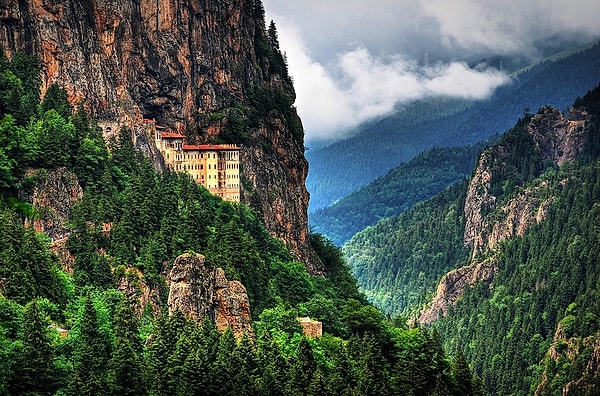
Sumela Monastery is nestled in the Altındere village of Maçka district, Trabzon province, sitting 1,150 meters above sea level. This ancient Greek Orthodox monastery and church complex, also known as Panagia Sumela or Theotokos Sumela, is steeped in legend and history. According to a popular story among the Black Sea Greeks, two monks named Barnabas of Athens and Sophronios shared a prophetic dream. In their dreams, they saw the monastery as the destined home for an icon of Mary holding baby Jesus, which was believed to be one of the three Panagia icons crafted by St. Luke, a disciple of Jesus. Driven by this vision, both monks traveled independently to Trabzon by sea. Upon meeting and discovering their shared dream, they joined forces to establish the first church at this majestic site.
2. Ishak Pasha Palace, Ağrı
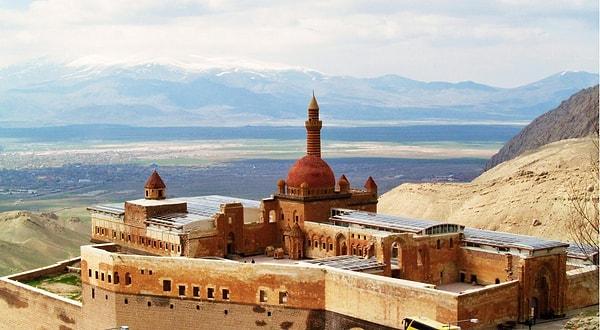
Located just 5 km from the Doğubeyazıt District, this palace stands on a hill on the eastern slopes of a mountain. It represents the last grand monumental structure of the Ottoman Empire from the Tulip Era. Constructed in the 18th century, it is not only a prime example of Ottoman architecture but also holds significant value in art history. According to the Takkapı inscription found in the Harem Department of the palace, it was built in 1784, marking it as a historic jewel of its time.
3. Mount Nemrut, Kahta, Adıyaman

Mount Nemrut, often referred to as the eighth wonder of the world, is recognized as a UNESCO World Cultural Heritage site due to its mesmerizing statues, which stand up to ten meters tall, and its extensive inscriptions. The site is not only famous for these impressive statues and the mausoleum it contains but also for offering some of the most spectacular sunrises and sunsets in the world. This stunning natural display draws thousands of visitors annually, who come to experience the breathtaking views of the sun rising and setting at Mount Nemrut.
4. Karagöl, Artvin
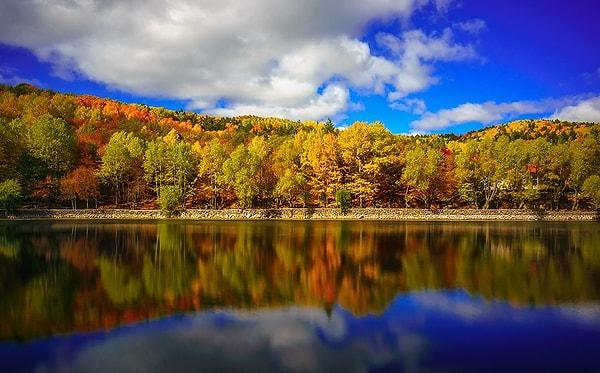
Karagöl, situated within the Artvin province, covers an area of 368 hectares. This lake is the result of a natural landslide that occurred in the early 19th century. A hill near today’s “Klaskur (Aralık) Plateau” collapsed, blocking the path of the Klaskur (Aralık) Stream and leading to the formation of Karagöl.
In the nearby Aralik village, there is a historic old stone bridge, adding to the area’s charm. The lake is surrounded by the Heba and Basın-Atanoğlu Plateaus, located within the boundaries of Aralik, Atanoğlu, and Karşıköy villages. These plateaus offer stunning panoramic views of the lake and are frequented during the summer months. However, Karagöl faces environmental threats, as erosion is causing the lake to gradually fill up.
5. Pamukkale, Denizli
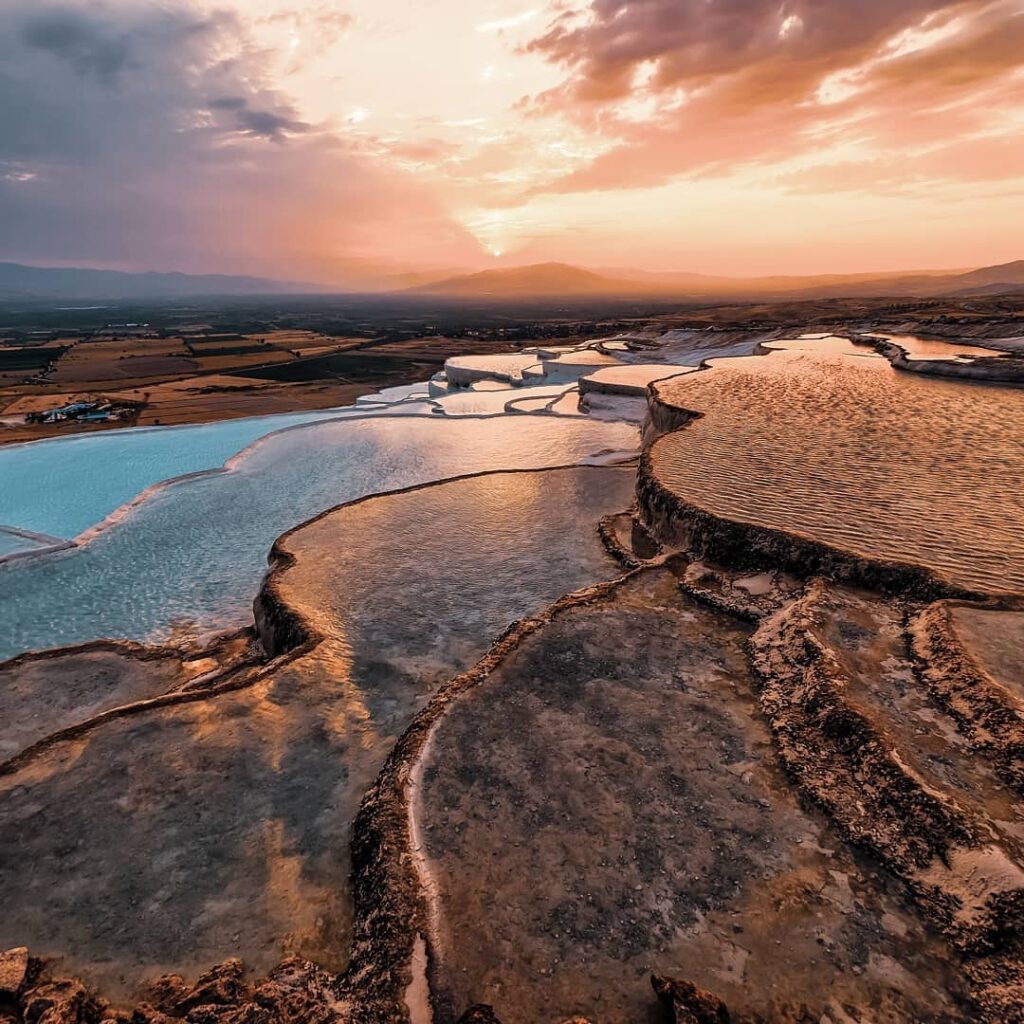
Pamukkale’s famous hot springs originate from the region’s geological faults and activities. This area boasts 17 distinct hot water springs, with temperatures varying from 35 to 100 degrees Celsius. Historically, these springs have been in use since ancient times, underscoring their long-standing appeal.
The journey of this thermal water is particularly interesting. It springs forth from its underground source and flows about 320 meters until it reaches the well-known travertine terraces. Here, the water spills over and meanders through the terraces for another 240 to 300 meters. As it flows, a series of chemical reactions occur, causing calcium carbonate to precipitate and initially form a soft, gel-like structure. Over time, this gel solidifies into travertine, the white, terraced formations that attract numerous tourists every year.
6. Kümbet Plateau, Giresun
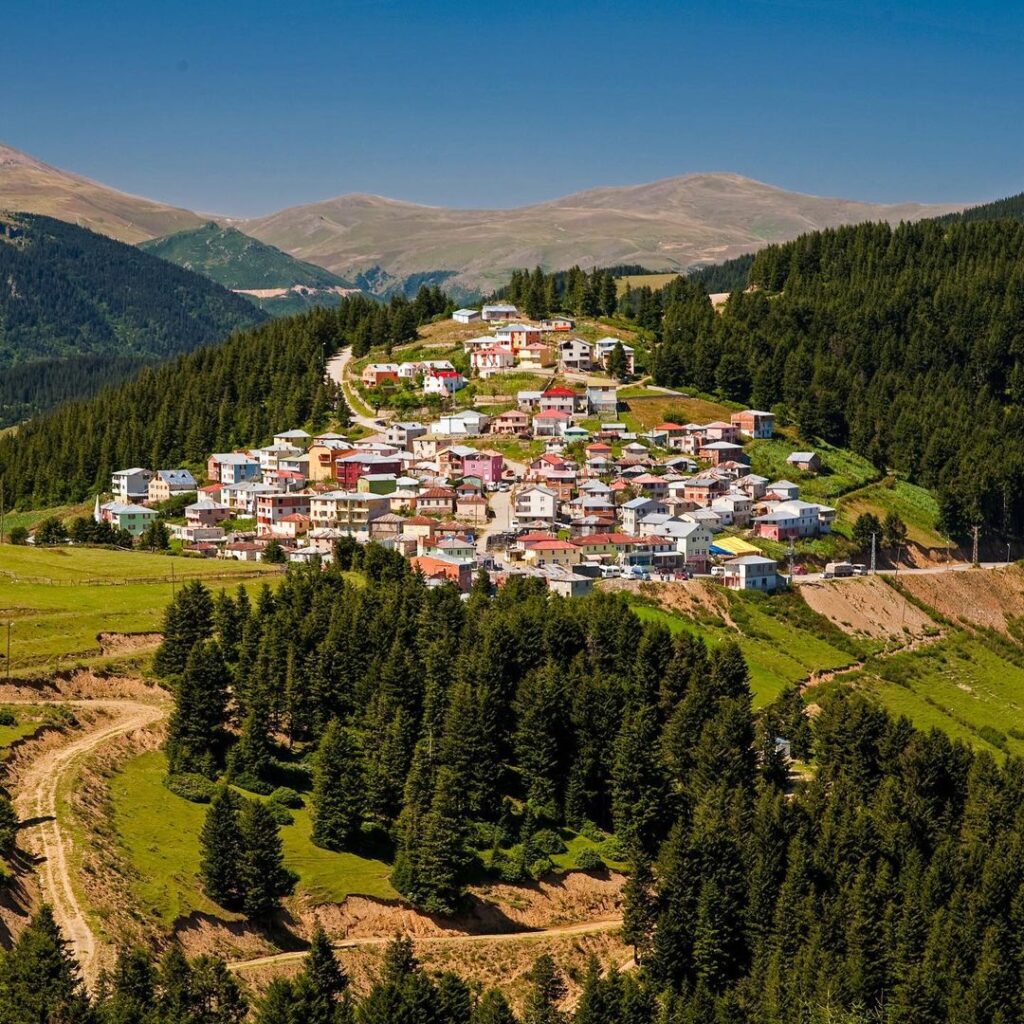
Kümbet Plateau, situated in the Eastern Black Sea region at an altitude of 1640 meters, is one of the region’s most popular tourist destinations. It lies within the Dereli district, approximately 52 km south of Giresun. The journey to the plateau is comfortable, with 30 km of asphalt road up to Dereli and an additional 22 km of new asphalt road from Dereli to Kümbet Plateau. During the summer months, minibusses regularly travel this route. For those interested in scenic routes, traveling to Kümbet Plateau via İkisu and returning via Güdül offers stunning views. It’s also accessible from Sivas and Central Anatolia through Şebinkarahisar.
The plateau is well-equipped with facilities. There is a tourist 5-star hotel complex, a PTT agency, a health center, and many shops including a grocery store, butcher, greengrocer, steakhouse, bakery, and even a country café. There’s also an auto mechanic available. The Kümbet Plateau, along with neighboring plateaus like Aymaç Hill, Şah İsmail Düzü, Melikli Obası, and Şıh Obası Yavuzkemal, are well-loved for camping and picnicking. This makes it an ideal destination for travelers looking for a mix of natural beauty and convenient amenities.
7. Mount Erciyes, Kayseri
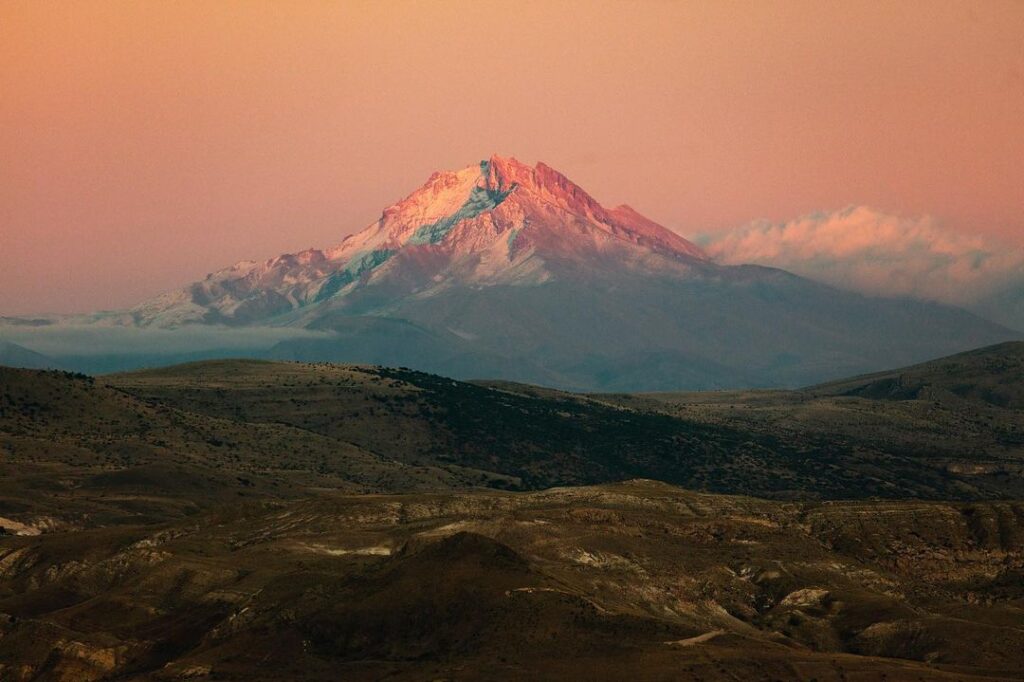
Mount Erciyes, standing at 3,917 meters, is a majestic symbol of Kayseri. Its towering peak, which pierces the clouds and is perpetually covered with snow, evokes a sense of divinity. This extinct “cluster volcano” began its volcanic activity around 30 million years ago. The ash from Erciyes, along with Mount Hasan, was carried by the wind across kilometers, contributing to the formation of Cappadocia’s famous fairy chimneys.
The northern part of Mount Erciyes hosts a kilometer-long glacier, and its summit remains snow-capped throughout the year. Additionally, caves at the mountain’s peak, once retreats for Byzantine priests, now serve as shelters for climbers during harsh weather.
Located just 30 km south of Kayseri, Erciyes is a prime destination for mountaineering and winter sports in Turkey. The Erciyes ski slope is renowned worldwide and ranks among the finest for skiing enthusiasts.
8. Xanthos Antik Kenti, Antalya – Muğla
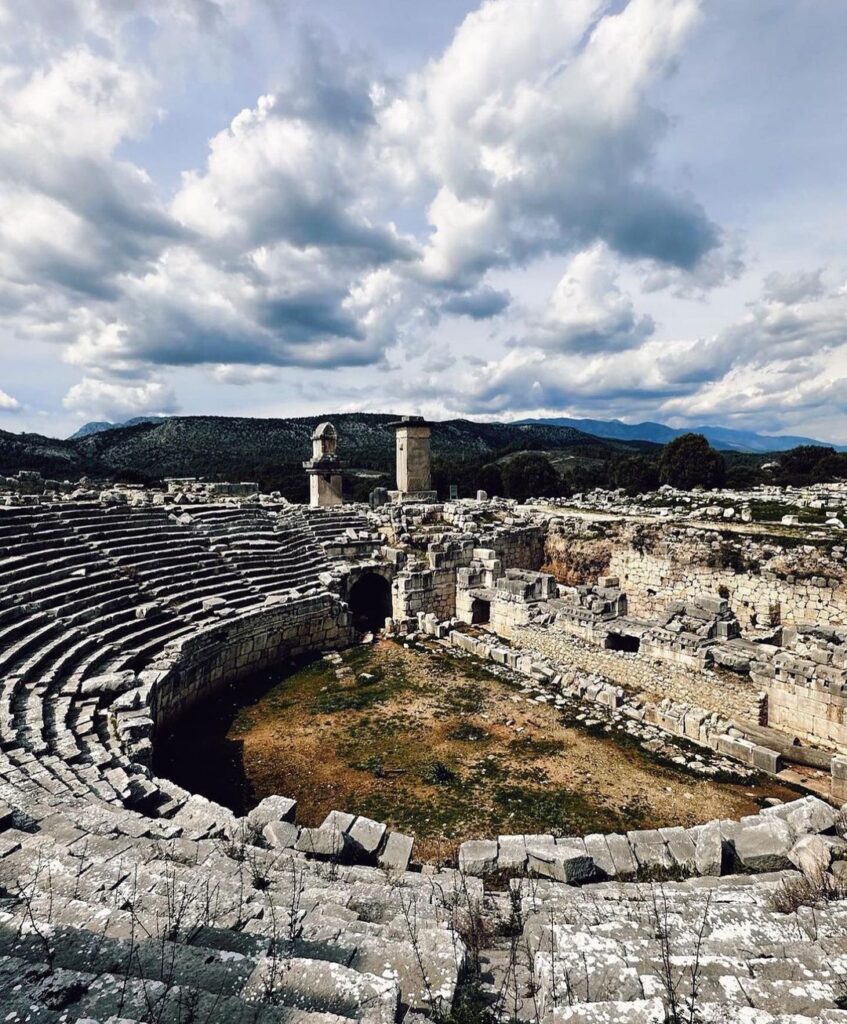
Located 46 km from Fethiye on the Fethiye-Kas highway, the ancient city of Xanthos sits in Kınık Village, near the banks of what is now known as the Esen Stream. Founded on two hills overlooking the plain, Xanthos holds a tragic yet resilient past. The site consists of two main parts: the Lycian Acropolis, which is encircled by walls and perched on a cliff beside the river, and the larger, higher Roman Acropolis to the north.
Xanthos is notable not just for its archaeological significance but also for its poignant history, often described as filled with suffering. Historical records indicate that the city was destroyed or burned down multiple times but remarkably rebuilt each time from its ashes. Known originally as ARNNA in Lycian inscriptions, Xanthos was the capital of Lycia. According to Homer, the city, under the rule of Sarpedon, participated in the Trojan Wars, marking its earliest mention in recorded history.
One of the most dramatic episodes in Xanthos’ history occurred in 546 BC when it was besieged by the Persian commander Harpagos. Facing inevitable defeat, the citizens of Xanthos chose to destroy their city and end their lives rather than surrender. They killed their women and children and set the city ablaze, leaving nothing but ruins for the invading Persians. However, 80 families who were absent during this tragedy later returned and, along with new settlers, rebuilt Xanthos.
Today, the ruins of Xanthos stand as a testament to the enduring spirit and turbulent history of its people, attracting visitors who come to pay homage to its past and explore its archaeological wonders.
Ancient City of Xanthos location
9. Mardin
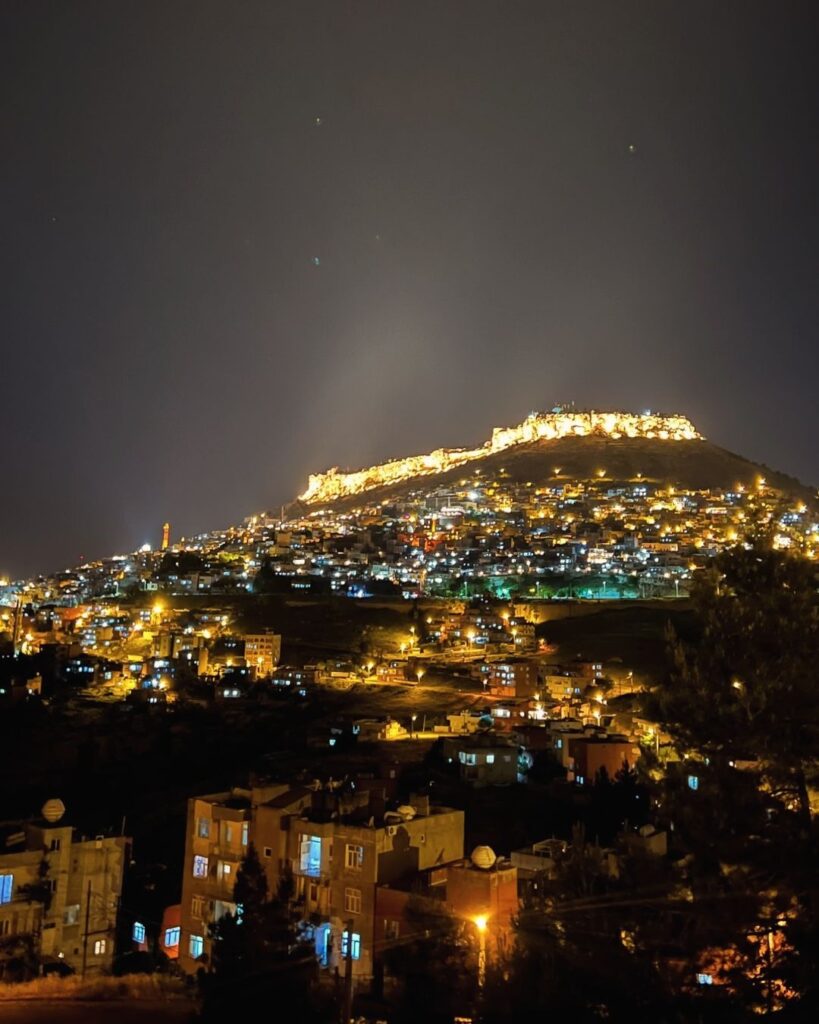
Mardin, set in Southeast Turkey, seems like a place frozen in time, enriched with stunning architectural and historical features. It’s a city where diverse religious traditions merge, hosting mosques, churches, mausoleums, and monasteries, all brimming with historical and artistic value. Mardin also lies on the old Silk Road and is home to five ancient inns and caravanserais that speak to its past importance in trade.
Perched on a mountain, Mardin offers a panoramic view over the Mesopotamia region, flanked by the Tigris and Euphrates rivers. As one of the oldest cities in Upper Mesopotamia, its history stretches back to 4500 BC. Over the ages, it has seen rule by various powers including the Aramean Syriacs, Subari, Sumerians, Akkadians, Babylonians, Mitanni, Assyrians, Persians, Byzantines, Arabs, Seljuks, Artuqids, and Ottomans. Each of these groups has left a mark, making Mardin a vibrant mosaic of the many cultures that have thrived here.
10. Cappadocia, Nevşehir

About 60 million years ago, the area now famous for its breathtaking landscapes was formed from lava and ash spewed by the volcanoes Erciyes, Hasandağ, and Güllüdağ. Over time, wind and rain sculpted these soft layers into the unique formations we see today.
Humans have lived in this region since the Paleolithic era. Originally the home of the Hittites, it later became a crucial hub for early Christians. The soft rock allowed these early settlers to carve out dwellings and churches directly into the cliffs, creating secure sanctuaries. These caves offered a haven for Christians escaping Roman persecution, embedding the area with a rich historical and spiritual legacy.
11. Ölüdeniz, Fethiye, Muğla
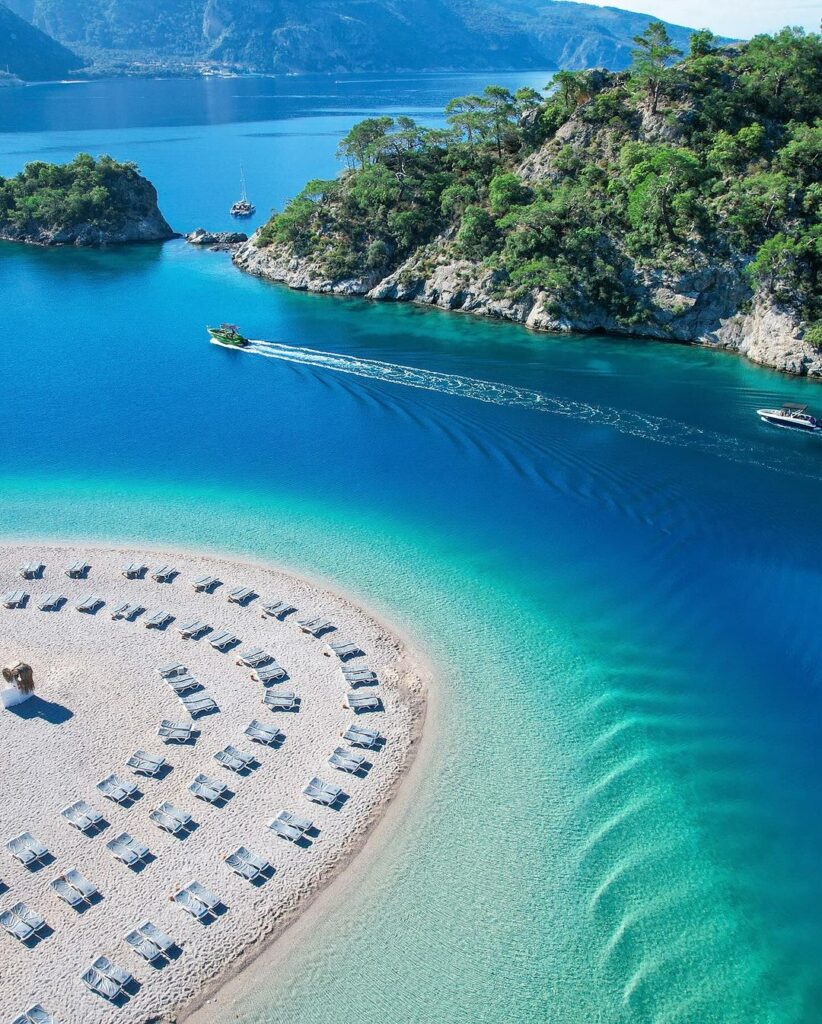
Ölüdeniz is a town in the Fethiye district of Muğla province, known for its breathtaking beauty. Voted the most beautiful beach in the world in 2006, the town is a major hub for tourists. Historically called the “land of light and sun” by the Lycians and “Far Land” in the Middle Ages, Ölüdeniz is situated on the Teke Peninsula in southwestern Anatolia and is one of Turkey’s rare lagoon formations.
The name Ölüdeniz translates to “stagnant lake,” reflecting the calmness of its waters. Even when nearby Belceğiz Beach faces rough waves during storms, only mild disturbances are seen in Ölüdeniz. Despite seeming still, the waters of Ölüdeniz refresh daily due to three natural phenomena:
- First, powerful underwater springs create a current that flows from Ölüdeniz towards the open sea.
- Second, these springs cause a salinity difference, prompting a continuous exchange of seawater.
- Third, the tidal movements raise and lower the sea level by about half a meter every few days, which helps in exchanging a large volume of seawater. These factors ensure that the water remains clean and vibrant, making Ölüdeniz a captivating destination for visitors worldwide.
12. Pokut Plateau, Çamlıhemşin, Rize
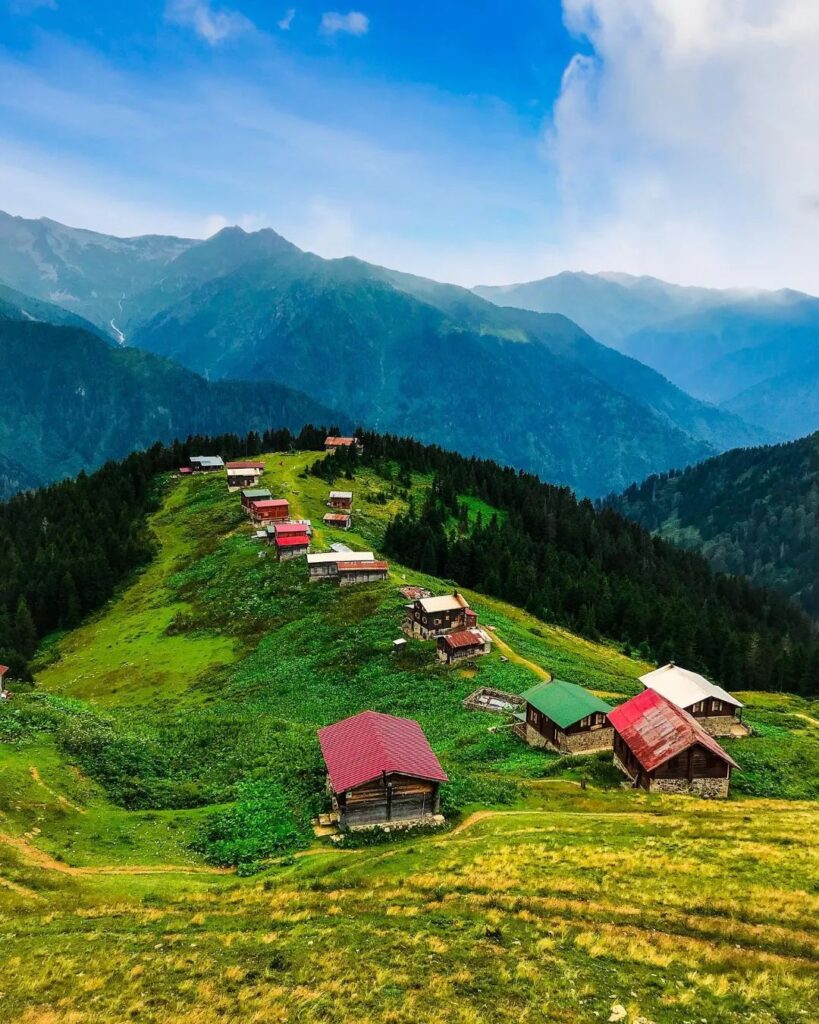
Pokut is a picturesque plateau located above Çamlıhemşin in the Hemşin region, sitting at an altitude of 2100 meters. It offers stunning views of the main Palovit valley and is encircled by expansive pine forests, making it a favorite spot for hikers and photography enthusiasts.
The architecture of Pokut is notably charming and historic, with houses that have stood for around one hundred and fifty years. These homes are built for durability and comfort, featuring a lower section of chipped stone that provides a strong foundation, topped with a wooden structure and metal-sheeted roofs. Typically, these houses include 2-3 rooms, a kitchen, and a food storage area known as a maran. The unique and authentic architectural style of these homes enhances the natural beauty of the Pokut plateau, making it a captivating destination for visitors.
13. Ballıca Cave, Tokat

Ballıca Cave, located 95 meters underground and stretching 680 meters long, is recognized as one of the largest and most spectacular caves globally. This natural marvel remains partly shrouded in mystery, with sections still unexplored and closed to the public. The experience of viewing the cave’s formations is akin to walking through a natural museum. Estimated to be around 3.4 million years old, Ballıca Cave holds international significance, not only for its comprehensive range of cave formations but especially for its unique Onion Stalactites.
Visiting the parts of Ballıca Cave that are open to the public offers a captivating and thrilling exploration. Each step through this cave presents a new wonder, making it an awe-inspiring journey into the depths of the earth.
14. Halfeti, Şanlıurfa
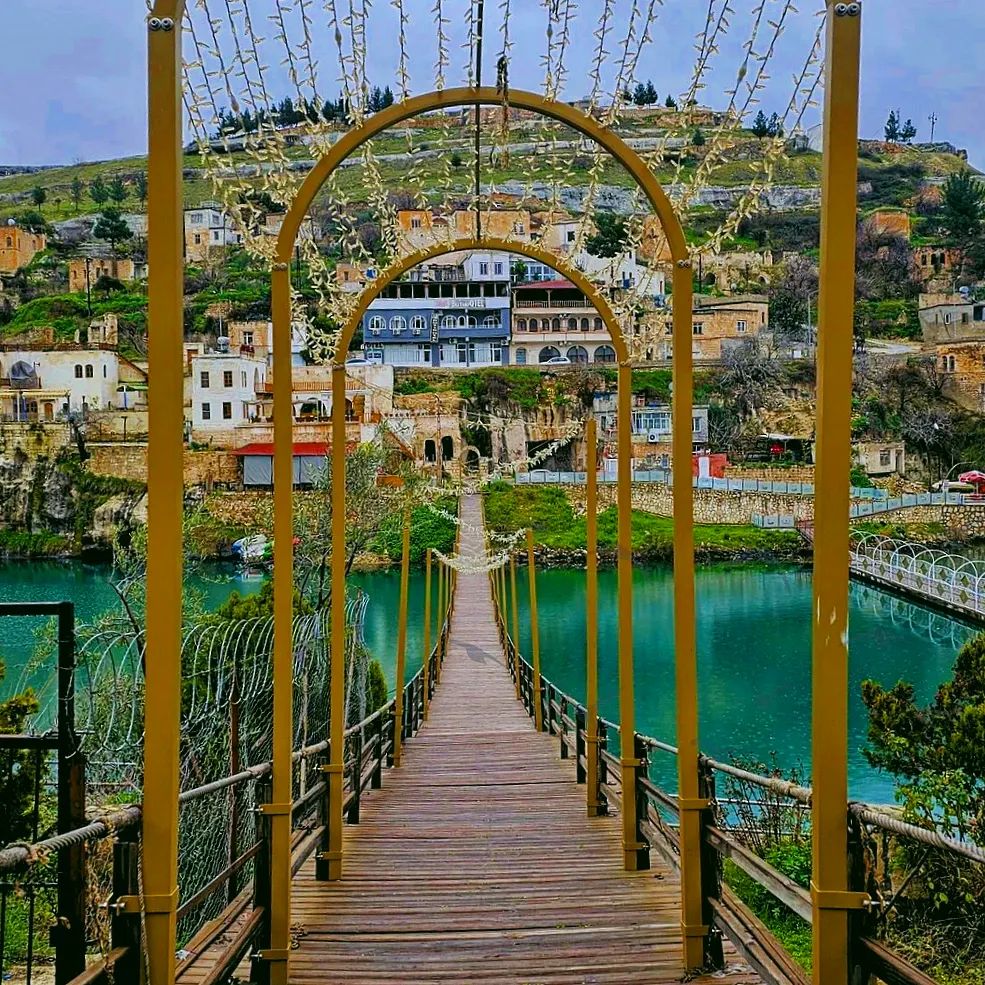
In 2002, the Birecik dam was built in the Halfeti district, leading to significant changes in the area. Most of Halfeti’s productive farmland was flooded, which drastically affected local agriculture, previously the main source of income. Consequently, many residents had to leave their homes in search of new livelihoods.
Halfeti’s terrain, characterized by rock formations and steppe ecosystems, doesn’t lend itself to industrial development. However, the flooding created a unique landscape where Greek-style stone houses now appear to rise directly out of the water. This scenic transformation has made Halfeti attractive to tourists and caught the attention of tourism professionals, suggesting a new direction for the local economy.
15. Hasankeyf, Batman

The origins of Hasankeyf are shrouded in mystery, as it’s unclear who founded the city or exactly when it was established. However, the presence of thousands of caves surrounding the city indicates that it has been a human settlement for a very long time. Hasankeyf is situated in the Mesopotamia region, one of the earliest cradles of civilization.
The city’s strategic importance has been sustained over the centuries due to several key features. It is bisected by the Tigris River, which not only provided a water source but also enhanced its geographic defensive capabilities. Additionally, the area is naturally fortified and the numerous caves in the vicinity were historically utilized as dwellings. The name “Hısn Keyfa,” which refers to its monolithic stone castle, underscores the city’s long-standing significance as a fortified site.
16. Basilica Cistern, Istanbul
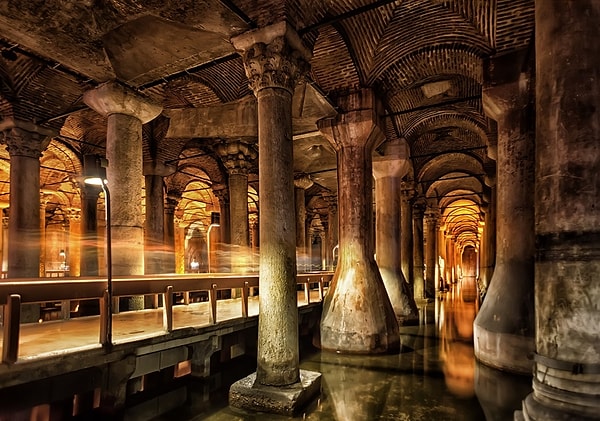
The Basilica Cistern, nestled in the heart of the Historical Peninsula, was constructed in 542 AD by Byzantine Emperor Justinian I to supply water to the Great Palace. Due to its grandeur and the striking marble columns that emerge from the water, it is commonly referred to as the Basilica Palace. The name “Basilica” is believed to originate from the Ilius Basilica which was located nearby, as mentioned in foreign texts.
This massive underground structure spans an area of 9,800 square meters and features 336 columns, each standing 9 meters tall. These columns are arranged in a grid of 12 rows with 28 columns in each, creating an impressive sight reminiscent of a vast forest. The sight of these towering columns rising from the water makes a lasting impression on visitors as soon as they step inside the cistern.
17. Akdamar Church, Van
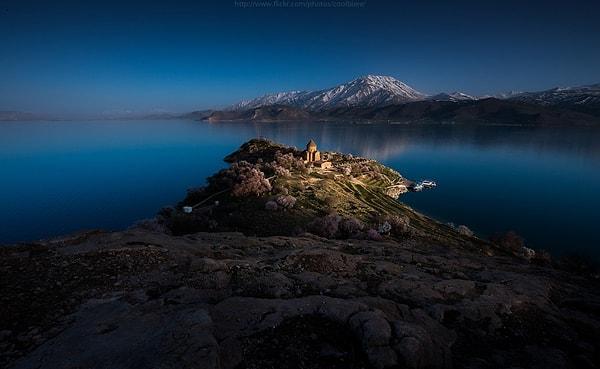
The Holy Cross Church on Akdamar Island is a stunning example of medieval Armenian architecture, built between 915-921 AD by the architect Manuel at the behest of King Gagik I. The church was specifically designed to house a piece of the True Cross, which legend says was brought to the Van region in the 7th century after being smuggled from Jerusalem to Iran. Situated on the southeast part of the island, this church is celebrated for its architectural brilliance and detailed artistry.
Constructed from red andesite stone, the exterior of the church is intricately decorated with plant and animal motifs carved in low relief, as well as scenes from the Bible, adding to its visual and historical richness. Over the years, several additions were made to the structure: a chapel was added in the northeast between 1296 and 1336, a community house (jamadun) to the west in 1793, and a bell tower in the south in the late 18th century. The origins of another chapel on the north side are still unknown.
For many years, the church was neglected but underwent extensive restoration from 2005 to 2007. This restoration, led by Turkey’s Ministry of Culture and Tourism, cost 1.5 million dollars and helped preserve this important cultural monument for posterity.
18. Uzungöl, Trabzon
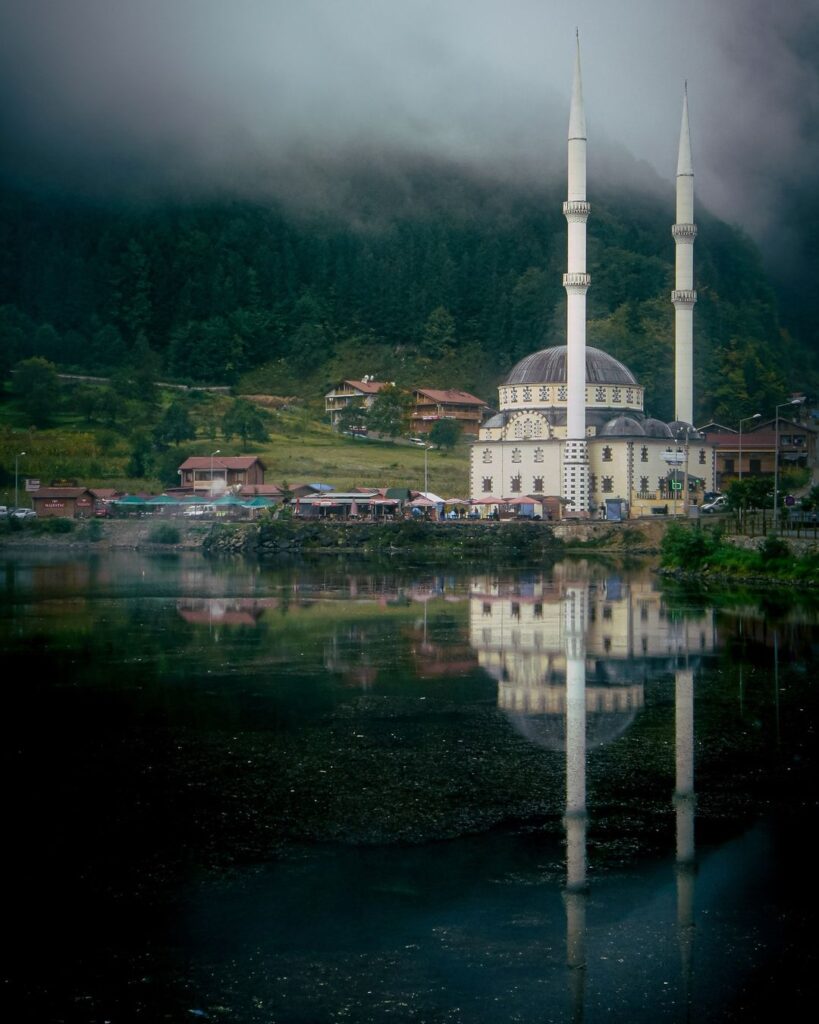
Uzungöl is a picturesque town in the Çaykara district of Trabzon, known for attracting both domestic and international tourists with its lush forests and stunning natural beauty. The town is named after the lake it borders, which itself was formed by rocks from the slopes blocking the Haldizen stream.
Located at the intersection of the Soğanlı and Kaçkar Mountain Ranges, Uzungöl is situated in one of Turkey’s rainforest areas, which are also some of the oldest temperate forests in the world. The area’s abundant rainfall and mild climate ensure that it remains verdant throughout the year. The mountains around Uzungöl, particularly Demirkapı and Soğanlı, are home to over 60 identified endemic plant species, contributing to its rich biodiversity.
The region also supports a variety of wildlife, including species such as brown bears, roe deer, lynxes, and mountain goats. Due to its ecological importance, Uzungöl has been designated as a Natural Protected Area, a Special Protection Environment, and a Nature Park, ensuring the conservation of its unique environment and wildlife for future generations.
19. Myra Ancient City, Antalya
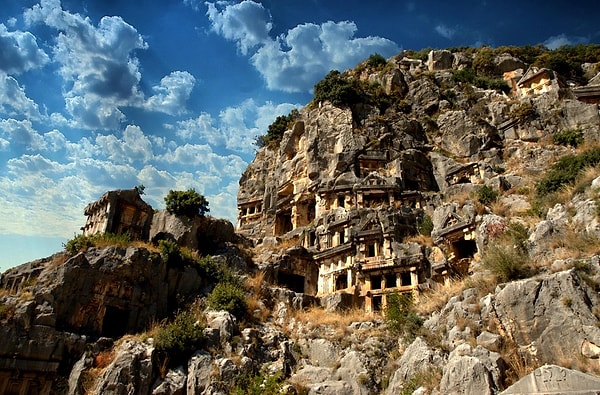
Located between Finike and Kaş, the ancient city of Myra is 25 km from Finike and 48 km from Kaş. It was one of the five major cities of ancient Lycia and dates back to the 5th century BC. Originally a coastal city, Myra now sits slightly inland due to the alluvium deposited by the Demre stream over the centuries.
Today, several notable structures from its past have survived. These include the impressive Rock Tombs carved into the cliffs, the ancient Theater which still stands as a testament to the city’s cultural past, and St. Nicholas Church, a significant historical site. These remnants offer a glimpse into the rich history of Myra and its importance in ancient Lycia.
20. Cumalıkızık Village, Bursa
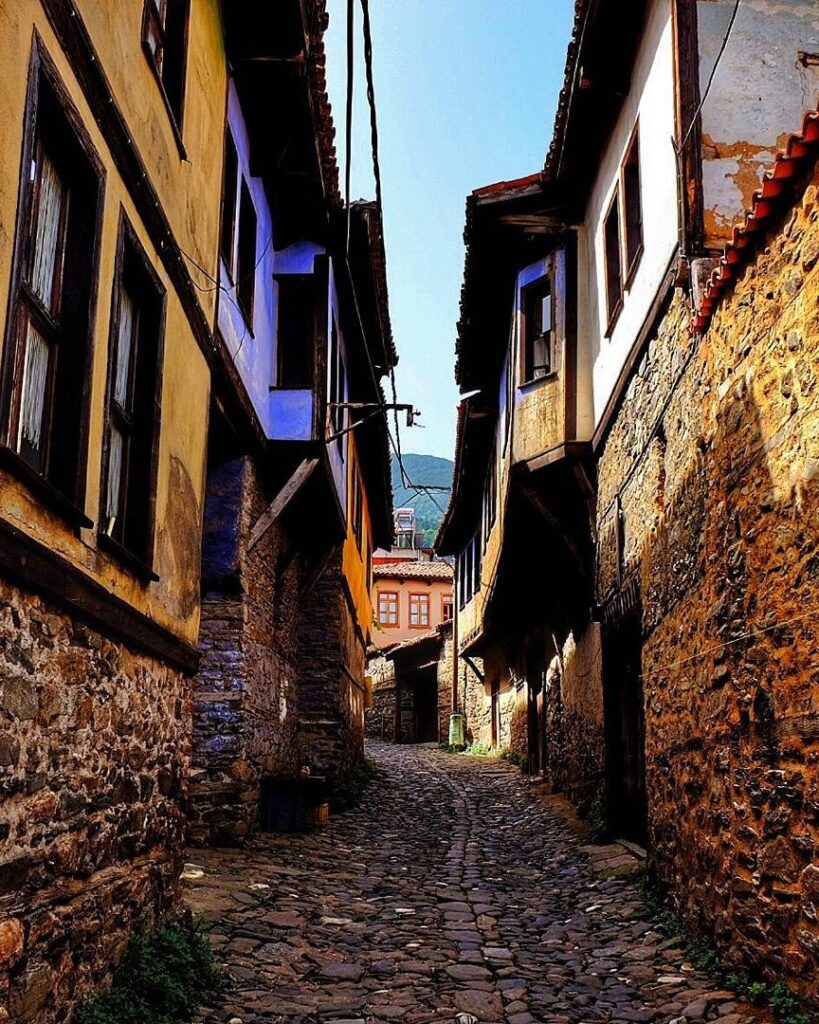
Cumalıkızık, established in the 1300s, is a village that has meticulously preserved its historical ambiance and showcases early Ottoman rural architecture still intact today. This distinctive character makes it a popular spot for tourists and a favored location for shooting historical films.
Located amid the foothills of Uludağ and its valleys, the area is part of a cluster known as Kızık. The name Cumalıkızık comes from its historical use as a meeting place for Friday prayers—’Cuma’ meaning ‘Friday’ in Turkish. Another story tells that Osman Bey named it Cumalıkızık because it was founded on a Friday.
In the village square, you’ll find the Cumalıkızık Ethnography Museum, which exhibits historical items from the village’s past. Each June, the village celebrates its local produce with a ‘Raspberry Festival.’ The famed Cumalıkızık houses, constructed from rubble stone, wood, and adobe, are generally three stories tall with latticed or bay windows on the upper floors. The houses’ main doors feature wrought iron handles and knockers, and the buildings are painted in vibrant colors such as yellow, white, blue, and purple. Narrow, stone-paved streets run between the houses, adding to the village’s quaint and colorful charm.


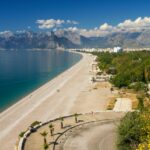
![10 Best Bakeries In Istanbul [2024] 3 Best Bakeries In Istanbul](https://artandthensome.com/wp-content/uploads/2023/11/367393269_18307347547098142_7278136094249273191_n-150x150.jpg)
![4 days in Istanbul Itinerary [2024] 4 4 Days In Istanbul Itinerary](https://artandthensome.com/wp-content/uploads/2024/07/pexels-izmapics-1030557148-21364462-150x150.jpg)
